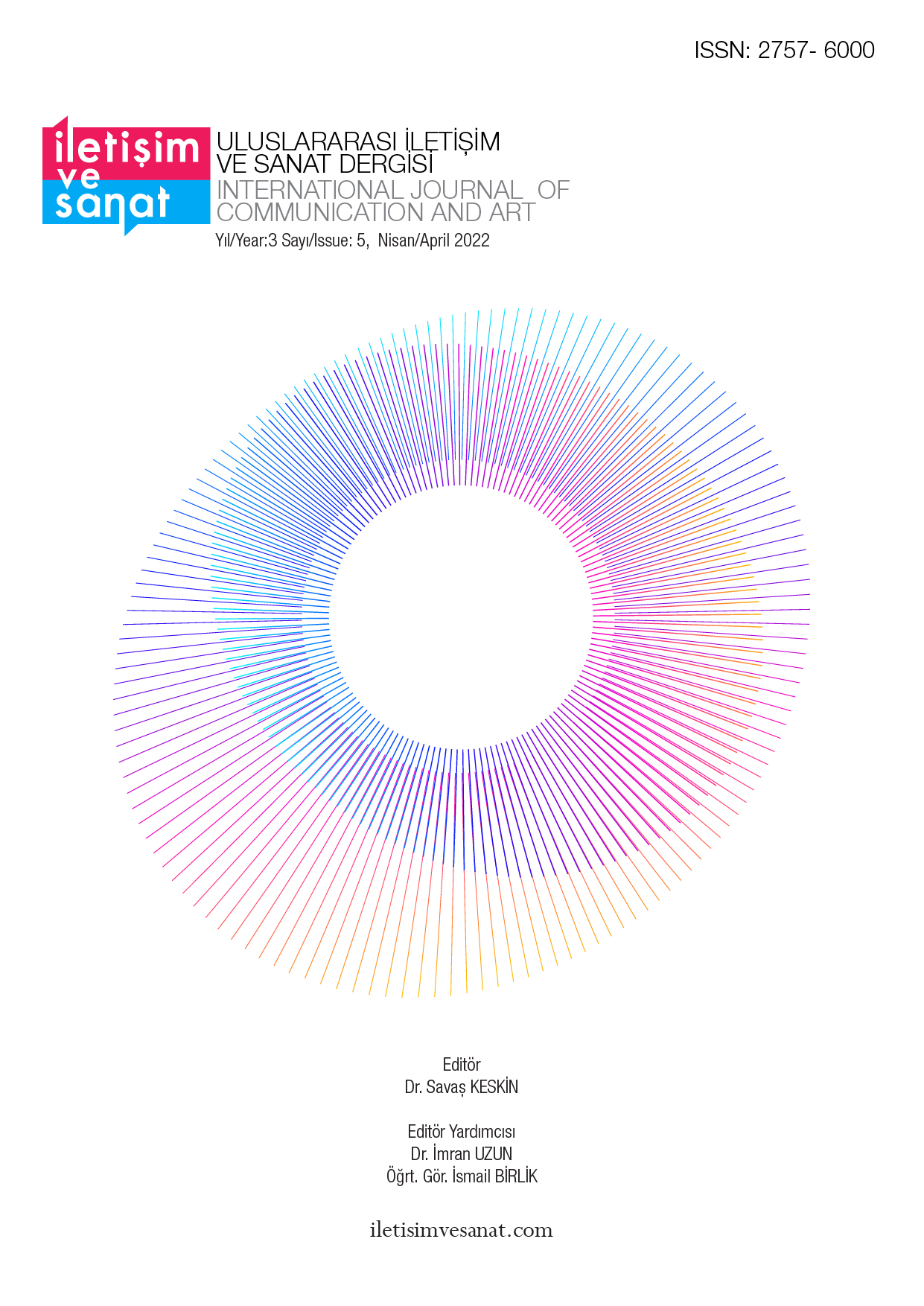Author :
Abstract
İnsanın ,korunma ve örtünme gereksiminden doğan dokumacılık , insanoğlunun yerleşik hayata geçişiyle birlikte dünyanın ilk el sanatına dönüşmüştür. Dokuma sanatı, zaman içinde farklı teknikler kullanılarak her dönem kendisini yenilemiştir.Bu tekniklerden birinın adı olan ''tapestry'' terimi zamanla ''dokuma resim,duvar halısı,resimli dokuma sanatı ve goblen '' olarak da literatürde kullanılmıştır.
Tapestry tekniğinde yapılan dokumalar,dokundukları döneme ait farklı desen , renk , materyal ve konu bazında oldukça çeşitlilik göstermişlerdir. 13 . ve 14 yüzyıllar arası Gotik sanatın izlerini taşırken ,14 . ve 16.yüzyıllar arası yapılan tapestryler Rönesans sanatı kapsamında ele alınmış o dönemde yapılan resimlerin birer prototip özelliğini taşımışlardır. 17. yüzyıl Avrupa'sında, sadece kralların ve asılların duvarlarını süsleyerek, gücün ve zenginliğin sembollü haline gelmiştir. 19.yüzyılda Endüstri devrimiyle ,bir hayri zor ve yüksek maliyetli tapestry dokumalara alaka azalmıştır. Bu durum, William Morris’in kuruculuğunu yaptığı Art&Crafts (Sanat ve Zanaat) hareketi ile biraz canlanmıştır.1919 'da ''Bauhaus okulunun '' açılmasıyla birlikte sanat ve zanaat birlikteliğini önemsenmiş, atölyelerin yeniden açılmasına destek olmuştur.
Bugün ise, günümüz sanatçıları tarafından farklı malzemeler ve teknikler kullanılarak , feminizm , küreselleşme ,çevre ,teknoloji ,kimlik, sınıf gibi kavramları yorumlayarak devam etmektedir . Grayson Perry, günümüz tapestry sanatının en farklı ve ikonik isimlerinden biri olarak nitelendirilmektedir. Bu çalışmada ,tapestry sanatının 17.yüzyıldan günümüze olan tarihsel yolculuğu ve günümüz çağdaş sanatçılarından Grayson Perry tarafından toplumsal sorunları ,kimlik kavramını '' Walthamstow Tapestry'' adlı eserinde ele alışı incelenmektedir.
Keywords
Abstract
Weaving has arisen from human’s need to protect and cover and became the first handicraft of the world with human beings’ transition to settled life. The art of weaving has renewed itself in each period by using different techniques over time. The term "tapestry", which is the name of one of these techniques, has also been used in the literature as "woven painting, tapestry, illustrated weaving art and Gobelin".
Weavings made in tapestry technique varied on the basis of different pattern, color, material, and subject in the period they were woven. Tapestries made between 13. and 14.centuries carried the Gothic art’s traces, while the ones made between 14. and 16. centuries were taken into the subject as a prototype of the paintings made at that time. It only adorned the walls of kings and nobles and became the symbol of power. Tapestry weaving became difficult and costlyand the interest in tapestry weaving decreased in 19. century with the Industrial Revolution. The Art & Crafts movement, which was founded by William Morris, helped to increase the interest. With the opening of the “Bauhaus school” in 1919, art and crafts unity were valued, and opening new workshops were encouraged.
Today, the tapestry progresses by modern artists using new materials and techniques and interpreting notions such as feminism, globalization, environment, technology, identity, and class. Grayson Perry is stated as one of the most diverse and iconic names of tapestry art. The aim of the study is to examine the historical journey of tapestry art from the 17. century until today and how Grayson Perry, one of the modern artists, approaches social problems, the concept of identity in his work “Walthamstow Tapestry.”
Keywords
- Ana Britannica Genel Kültür Ansiklopedisi (1987). Duvar halısı içinde (552. ss.), İstanbul : Ana Yayıncılık. A. Ş.
- Arabalı Koşar, S. T. (2007). 10.- 17. Yüzyıllar Arasında Fransa’da Tapestry Sanatı Ve Gelişim Süreci (Yüksek lisans tezi, T.C. Dokuz Eylül Üniversitesi, İzmir). Erişim adresi: https://tez.yok.gov.tr/UlusalTezMerkezi/tezDetay.jsp?id=o4uCdmqfQ_HICDgk1jakw&no=jy6YkyZp8JeUrGZ-2x3gyg
- Arslan, S. (2012). Resmin Dokunması. Selçuk Üniversitesi Sosyal Bilimler Enstitüsü Dergisi, 27, 45-57. https://dergipark.org.tr/tr/pub/susbed/issue/61804/924488
- Bloomberg Quicktake: Originals.( 2015, 17 Eylül ). Brilliant Ideas: Artist Grayson Perry [Video]. Erişim adresi: https://www.youtube.com/watch?v=PI2JG67b-fs&t=213s
- Böçkün, R. (2018). Grayson Perry'nin Walthamstow Tapestry İşi Üzerine İkonografik Çözümleme (Yüksek lisans tezi, T.C. Batman Üniversitesi, Batman). Erişim adresi: https://tez.yok.gov.tr/UlusalTezMerkezi/tezSorguSonucYeni.jsp
- IV. Henry. Vikipedi içinde. Erişim adresi (23 Nisan 2022): https://tr.wikipedia.org/wiki/IV._Henry,
- Kalender, E. (1997). Türk Halı Sanatı Tarihinde Savonnerie ve Aubusson Halılarının Yeri. Arış Dergisi , 3 , 48-53. https://doi.org/10.34242/akmbaris.2019.101
- Moredock, J. (2022, Mart 20). Grayson Perry. Encyclopedia Britannica içinde (26.04.2022): https://www.britannica.com/biography/Grayson-Perry
- Pera Müzesi Sergi Katalogu, (2015, Mayıs). Grayson Perry Küçük Farklılıklar. İstanbul: Pera Müzesi Yayınları
- Saç Kavrayan, Ç. (2019). Çağdaş Sanat ve Kimlik: Grayson Perry Eserleri Üzerinden Bir İnceleme. İnsan&İnsan, 19, 63-77. https://doi.org/10.29224/insanveinsan.407617
- Sözen, M., Tanyeli, U.(2010). Sanat kavram ve terimleri sözlüğü içinde (17. bs., 117. ss.).İstanbul: Remzi Kitabevi.
- Özay, S. (2001). Dünden bugüne dokuma resim sanatı. Ankara: T. C. Kültür Bakanlığı.
- Zaimoğlu, Ö. (2011). Tapestry (Goblen) Dokumaları . Arış Dergisi, 5, 144-151. https://doi.org/10.34242/akmbaris.2019.14
- ''Alan Miesels (Alan Kızamık)'', Grayson Perry'in Oyuncak Ayısı Görseli. Erişim adresi (24.12.2020) https://www.economist.com/1843/2020/01/21/grayson-perry-theteddy-bear-that-is-like-a-god-to-me
- Arts And Crafts Sergi Derneği Bilet Detayı Görseli. Erişim adresi (24.12.2020): https://www.arkitektuel.com/bir-mimari-baskaldiri-artscrafts/
- Av Sahneli Duvar Halısı Görseli. Erişim adresi (25.04.2022): https://stringfixer.com/tr/Hunting
- Dessau'da Bauhaus Ustalarının Grup Fotoğrafı Görseli. Erişim adresi: (28.02.2021) https://www.goethe.de/ins/cy/tr/kul/sup/bih/21356319.html
- Elinde Oyuncak Tutan Çocuk Görseli. Erişim adresi (28.02.2021) https://www.pinterest.co.uk/pin/51650726947158764/
- Goblein Fabrikası Görseli. Erişim adresi (07. 01. 2021): https://www.unjourdeplusaparis.com/paris-culture/visiter-manufacture-desgobelins
- The Forest( Orman) Tapestry Görseli. Erişim adresi (25.04.2022): https://tapestry- art.com/tapestries/the-forest-tapestry/





